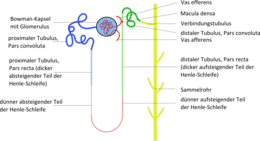Nephron

A nephron (from the ancient Greek νεφρός nephros, German 'kidney') is the functional subunit of the kidney. The nephron is considered the smallest kidney functional unit. It consists of:
- the renal corpuscle (Malpighi corpuscle, named after Marcello Malpighi; corpusculum renale), with the glomerulum (kidney ball) in Bowman's capsule and
- the connected renal tubule (tubule). The renal tubule is divided into the main section (proximal tubule), the transition section (intermediate tubule or tubule attenuatus) and the middle section (distal tubule). The straight sections of the renal tubules and the transition piece form a loop called Henle's loop (after Jakob Henle, Latin Ansa nephroni). The loops of Henle exist only in mammals and birds. They are obviously necessary to form a hyperosmotic urine compared to the blood, because vertebrates without loops of Henle are not able to do so.
The connecting tubule and collecting tube are embryologically of a different origin and therefore do not belong to the nephron. However, they form a functional unit with the tubule system of the nephron. The distal tubule is distal with respect to the nephron.
Each human kidney has about one million of these morphological or physiological subunits and thus just as many renal corpuscles, renal tubules and renal tubules. These three German terms are hardly used today; they are also missing, for example, in both the 11th and 19th editions of the Brockhaus Encyclopedia. The tubules function (despite a postulated tubuloglomerular feedback) largely independently of the glomeruli.

The figure shows the different sections of the tubular system. ATTENTION: The macula densa is attached to the vas afferens and not to the vas efferens as shown in the picture.
Physiology
In the renal corpuscles, primary urine is continuously filtered from the blood. Subsequently, certain substances are reabsorbed in the tubules (especially water is "reabsorbed", reabsorbed, water reabsorption), but also secreted. Through this concentration, the primary urine becomes the actual urine (secondary urine or final urine). Primary urine formation is also called glomerular filtration, filtrative renal function, or creatinine clearance; it is about 150 liters per day (or 105 ml/min) in adults.
The tubules regulate the water balance, the glomeruli filter the plasma, each in proportion to the variable cardiac output.
The actual renal performance consists in the active transport of the tubules (under energy consumption) in contrast to the hemodynamically generated (passive) filtration of the glomeruli. The active transport processes in the renal tubules are divided into primary active, secondary active and tertiary active.
History
The theories of urine preparation have a long history. Leonhart Fuchs (1501-1566) already described the kidney as a sieve or filter. The Austrian anatomist Josef Hyrtl also referred to a kidney as a seihe (seyhe) or sieve. William Bowman claimed as late as 1842 that the glomerular capillaries secrete water, which washes away the substances secreted by the tubules. Carl Ludwig also first had a clear idea of how the kidneys work in the preparation of urine in 1842. According to his mechanical theory, which is still essentially valid today, the physical filtration of the plasma takes place in the glomeruli. Subsequently, water is re-diffused through endosmosis in the tubule.
The tubular reabsorption of urinary substances was not recognized until 1917 by Arthur Robertson Cushny. Today we speak of (passive, i.e. without energy consumption) glomerular filtration and (active, i.e. with energy consumption) tubular reabsorption. Already Franz Volhard rejected this "modern mechanical-physical filtration theory", although he described it correctly in detail several times ("Filtration-reabsorption theory of Ludwig and Cushny"). In 1934, Leopold Lichtwitz also considered even the possibility of filtration and ultrafiltration in the glomeruli to be impossible, because he could not imagine the passive passage of urinary substances through the slit membranes in the podocytes almost without energy consumption.
However, the interplay of physics and chemistry (neurohumorally regulated and drug-modulated) in health and disease in the podocytes and in the individual tubule sections with respect to the individual urinary and urinary substances has not been conclusively clarified even today.
Search within the encyclopedia